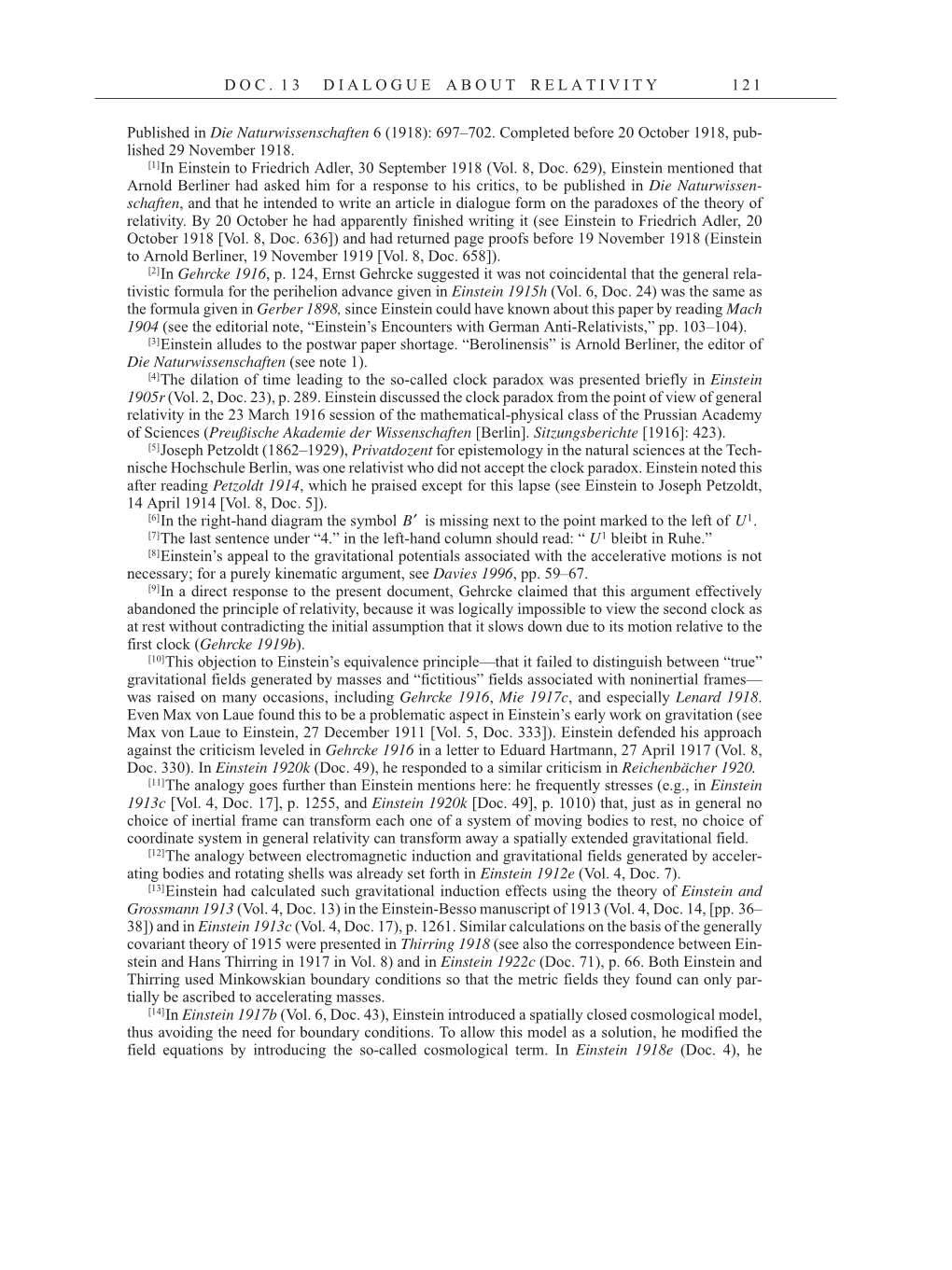D O C . 1 3 D I A L O G U E A B O U T R E L A T I V I T Y 1 2 1
Published in Die Naturwissenschaften 6 (1918): 697–702. Completed before 20 October 1918, pub-
lished 29 November 1918.
[1]In Einstein to Friedrich Adler, 30 September 1918 (Vol. 8, Doc. 629), Einstein mentioned that
Arnold Berliner had asked him for a response to his critics, to be published in Die Naturwissen-
schaften, and that he intended to write an article in dialogue form on the paradoxes of the theory of
relativity. By 20 October he had apparently finished writing it (see Einstein to Friedrich Adler, 20
October 1918 [Vol. 8, Doc. 636]) and had returned page proofs before 19 November 1918 (Einstein
to Arnold Berliner, 19 November 1919 [Vol. 8, Doc. 658]).
[2]In Gehrcke 1916, p. 124, Ernst Gehrcke suggested it was not coincidental that the general rela-
tivistic formula for the perihelion advance given in Einstein 1915h (Vol. 6, Doc. 24) was the same as
the formula given in Gerber 1898, since Einstein could have known about this paper by reading Mach
1904 (see the editorial note, “Einstein’s Encounters with German Anti-Relativists,” pp. 103–104).
[3]Einstein alludes to the postwar paper shortage. “Berolinensis” is Arnold Berliner, the editor of
Die Naturwissenschaften (see note 1).
[4]The dilation of time leading to the so-called clock paradox was presented briefly in Einstein
1905r (Vol. 2, Doc. 23), p. 289. Einstein discussed the clock paradox from the point of view of general
relativity in the 23 March 1916 session of the mathematical-physical class of the Prussian Academy
of Sciences (Preußische Akademie der Wissenschaften [Berlin]. Sitzungsberichte [1916]: 423).
[5]Joseph Petzoldt (1862–1929), Privatdozent for epistemology in the natural sciences at the Tech-
nische Hochschule Berlin, was one relativist who did not accept the clock paradox. Einstein noted this
after reading Petzoldt 1914, which he praised except for this lapse (see Einstein to Joseph Petzoldt,
14 April 1914 [Vol. 8, Doc. 5]).
[6]In the right-hand diagram the symbol is missing next to the point marked to the left of
[7]The last sentence under “4.” in the left-hand column should read: “ bleibt in Ruhe.”
[8]Einstein’s appeal to the gravitational potentials associated with the accelerative motions is not
necessary; for a purely kinematic argument, see Davies 1996, pp. 59–67.
[9]In a direct response to the present document, Gehrcke claimed that this argument effectively
abandoned the principle of relativity, because it was logically impossible to view the second clock as
at rest without contradicting the initial assumption that it slows down due to its motion relative to the
first clock (Gehrcke 1919b).
[10]This objection to Einstein’s equivalence principle—that it failed to distinguish between “true”
gravitational fields generated by masses and “fictitious” fields associated with noninertial frames—
was raised on many occasions, including Gehrcke 1916, Mie 1917c, and especially Lenard 1918.
Even Max von Laue found this to be a problematic aspect in Einstein’s early work on gravitation (see
Max von Laue to Einstein, 27 December 1911 [Vol. 5, Doc. 333]). Einstein defended his approach
against the criticism leveled in Gehrcke 1916 in a letter to Eduard Hartmann, 27 April 1917 (Vol. 8,
Doc. 330). In Einstein 1920k (Doc. 49), he responded to a similar criticism in Reichenbächer 1920.
[11]The analogy goes further than Einstein mentions here: he frequently stresses (e.g., in Einstein
1913c [Vol. 4, Doc. 17], p. 1255, and Einstein 1920k [Doc. 49], p. 1010) that, just as in general no
choice of inertial frame can transform each one of a system of moving bodies to rest, no choice of
coordinate system in general relativity can transform away a spatially extended gravitational field.
[12]The analogy between electromagnetic induction and gravitational fields generated by acceler-
ating bodies and rotating shells was already set forth in Einstein 1912e (Vol. 4, Doc. 7).
[13]Einstein had calculated such gravitational induction effects using the theory of Einstein and
Grossmann 1913 (Vol. 4, Doc. 13) in the Einstein-Besso manuscript of 1913 (Vol. 4, Doc. 14, [pp. 36–
38]) and in Einstein 1913c (Vol. 4, Doc. 17), p. 1261. Similar calculations on the basis of the generally
covariant theory of 1915 were presented in Thirring 1918 (see also the correspondence between Ein-
stein and Hans Thirring in 1917 in Vol. 8) and in Einstein 1922c (Doc. 71), p. 66. Both Einstein and
Thirring used Minkowskian boundary conditions so that the metric fields they found can only par-
tially be ascribed to accelerating masses.
[14]In Einstein 1917b (Vol. 6, Doc. 43), Einstein introduced a spatially closed cosmological model,
thus avoiding the need for boundary conditions. To allow this model as a solution, he modified the
field equations by introducing the so-called cosmological term. In Einstein 1918e (Doc. 4), he
B′ U1.
U1
